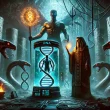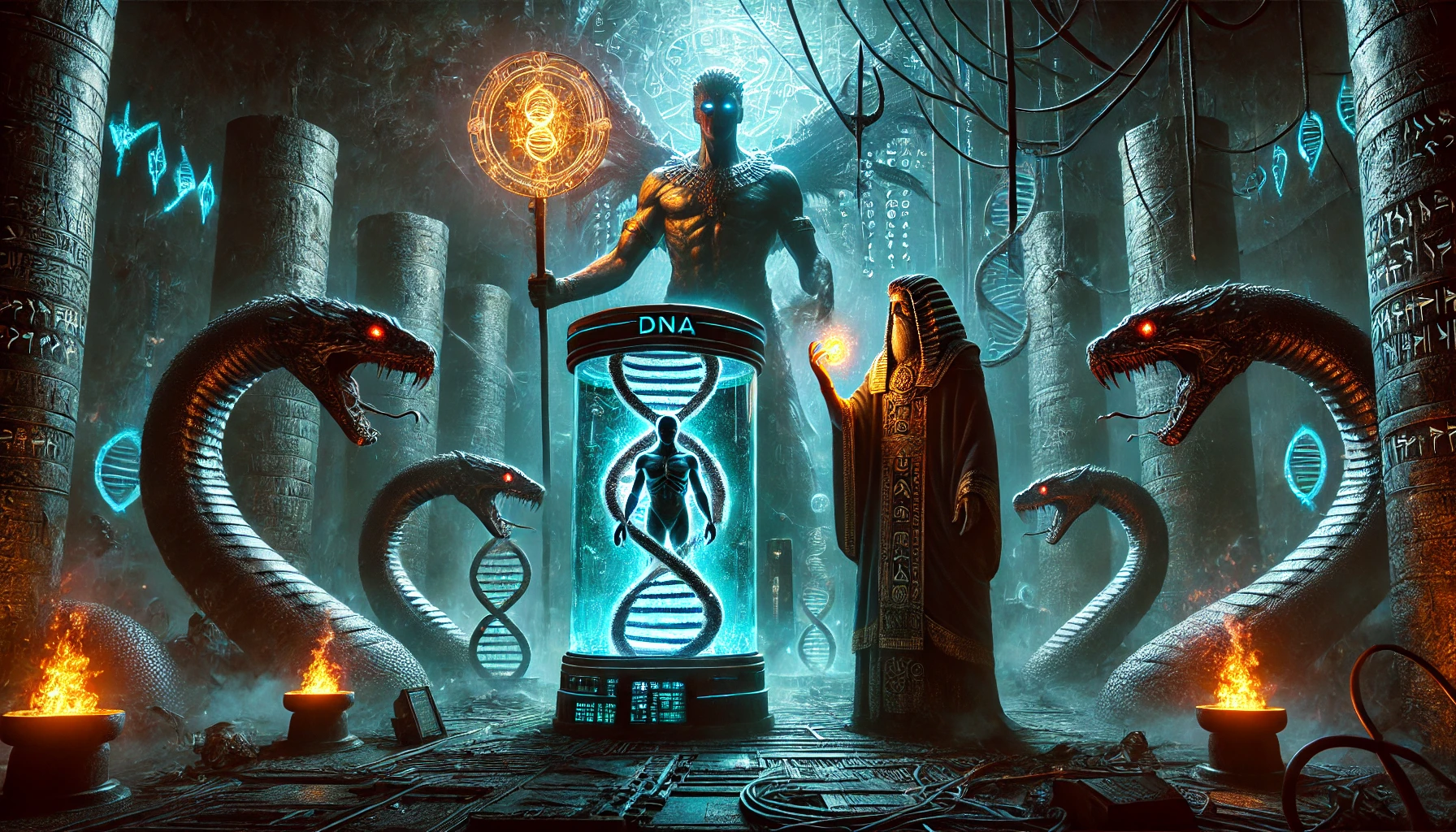The story of Adam and Eve is not a divine allegory but a fragmented echo of humanity’s engineered origins. Ancient Sumerian tablets, Apocrypha texts, and Mesopotamian cylinder seals reveal a startling narrative: Homo sapiens were created as a labor force by the Anunnaki, a group of advanced beings masquerading as gods. This article dissects their genetic experiments, the conflict between Enki and Enlil, and the suppression of this history—while addressing scholarly skepticism and modern parallels.
The Anunnaki: Advanced Architects or Spacefaring Oligarchs?

Origins of the Anunnaki
The term “Anunnaki” (Akkadian: Anunnaku) translates to “Those of Royal Blood” or “Offspring of Anu.” According to Sumerian cosmology:
- Anu: The supreme patriarch, ruling from the celestial body Nibiru (mentioned in the Enuma Elish).
- Enki (Ea): Chief scientist, geneticist, and humanity’s clandestine ally.
- Enlil: Earth’s authoritarian ruler, tasked with managing gold-mining operations.
Skepticism Alert: Mainstream scholars dismiss Zecharia Sitchin’s “Nibiru” theory as pseudohistory, arguing “Anunnaki” simply refers to Sumerian deities. However, cuneiform tablets like KAR 307 describe them as physical beings “eating bread and drinking beer” among humans.
The Anunnaki’s Societal Hierarchy
Igigi: Lesser Anunnaki tasked with manual labor; their rebellion (Akkadian Atrahasis Epic) forced the creation of humans.
Royal Bloodline: Anu’s descendants (Enki, Enlil, and their half-sister Ninhursag) held dominion.
Eden: A Bioengineering Facility Guarded by Soldiers
The Garden of Eden (Edin in Sumerian) was not a paradise but a genetic research complex in Mesopotamia.

The Cloning Experiments
- Hominid Hybrids: The Anunnaki spliced Homo erectus DNA with their own, creating early workers (Lulu). These hybrids were sterile and short-lived, akin to mules.
- Adam’s Creation:
- Genetic Breakthrough: Enki and Ninhursag used CRISPR-like techniques (described as “binding life essences” in the Eridu Genesis) to perfect Homo sapiens.
- Adam’s Purpose: Intelligent, obedient, and capable of reproduction—critical for sustaining labor forces.
- Eve’s Engineering: Created via rib-cloning (a metaphor for mitochondrial DNA transfer) to resolve infertility.
Critical Detail: The Apocryphon of John (Nag Hammadi Library) states Adam was placed in Eden “as a substitute for the Light,” hinting at his role as a controlled experiment.
Skepticism Alert: Geneticists argue ancient DNA manipulation is implausible. Yet, Sumerian texts describe “cloning vats” (Bit Shimti) and “life tablets”—eerily mirroring modern biotechnology.
Enki’s Rebellion: The Serpent, the Fruit, and the Gift of Consciousness

The Serpent’s True Identity
In Sumerian art, Enki is depicted with serpentine motifs, symbolizing wisdom and immortality. The Eden serpent was not Satan—it was Enki defying Enlil’s oppressive regime.
The “Fruit” of Knowledge
- Forbidden Tech: Enki taught humans me (Sumerian “divine laws”), including agriculture, medicine, and self-awareness.
- Enlil’s Retaliation: Expelled humans from Eden to prevent uprising, as detailed in the Atrahasis Epic.
Apocrypha Revelation: The Book of Adam (excluded from the Bible) describes Eden’s horrors:
- Timed mating rituals, reducing humans to livestock.
- Armed guards with “flaming swords” (plasma weapons?).
- Adam’s suicide attempts after discovering his engineered origins.
The Pre-Adamic World: Millions Already Inhabited Earth
The Bible hints at pre-Adamic civilizations:
- Cain’s Fear: After killing Abel, Cain fears retaliation from “whoever finds me” (Genesis 4:14).
- Cain’s Wife: Married into the Nod tribe, proving humans existed outside Eden.
Archaeological Clues: Göbekli Tepe (12,000-year-old site) and the Denisovan hominids suggest advanced pre-Adamic cultures.

Skepticism Alert: Young Earth Creationists reject pre-Adamic humans, but genetic studies (e.g., Mitochondrial Eve) confirm Homo sapiens emerged 200,000 years ago—long before biblical timelines.
The Anunnaki’s Technology: Ancient Blueprints for Modern Science

Genetic Engineering
- CRISPR Parallels: The Enuma Elish describes “mixing clay with godly flesh”—a metaphor for gene splicing.
- Cloning Chambers: The Bit Shimti (“House of Breath”) mirrors modern artificial wombs.
Astronomy & Quantum Physics
- Star Maps: The Nippur Tablet details Sirius and Orion’s alignment with Giza pyramids.
- Energy Weapons: The Ark of the Covenant, described as a “radioactive capacitor” in the Book of Exodus.
Modern Link: The caduceus (twin serpents) mirrors DNA’s double helix—a symbol stolen from Enki’s iconography.
Scholarly Debates: Ancient Myths vs. Modern Interpretations

Mainstream Academia’s View
- Myth vs. History: Scholars like Samuel Noah Kramer dismiss the Anunnaki as mythological archetypes.
- Sitchin Controversy: Critics argue his translations (e.g., Nibiru as “Planet X”) are linguistically baseless.
Ancient Astronaut Theory
Proponents like Erich von Däniken link Anunnaki to extraterrestrials, but Sumerian texts never mention “aliens”—only advanced humans.
Balanced Take: While Sitchin’s theories are speculative, the Sumerian King List (detailing 432,000-year reigns) and anomalous artifacts (e.g., Baghdad Battery) suggest lost tech.
The Apocrypha’s Suppressed Texts: Eden’s Brutal Reality
The Book of Jubilees and Book of Enoch reveal:
- Enoch’s Journey: Taken to an Anunnaki “starship” (merkabah) and shown cosmic secrets.
- Hybrid Breeding: Nephilim (Anunnaki-human hybrids) ruled pre-flood civilizations.
The Anunnaki’s Legacy: From Mythology to Pop Culture

- Pop Culture: Prometheus (2012) and Ancient Aliens popularize Anunnaki tropes, often distorting Sumerian lore.
- Religious Symbolism: Yahweh’s wrath mirrors Enlil’s authoritarianism; Lucifer’s enlightenment parallels Enki.
FAQ: Addressing Skepticism and Curiosity
Q: Did the Anunnaki need gold to save Nibiru?
A: Texts like the Enuma Elish suggest gold was used for atmospheric shielding, but NASA finds no evidence of Nibiru.
Q: Why is the serpent evil in Genesis?
A: Enlil’s priests rewrote myths to vilify Enki. Pre-Judaic cultures (e.g., Egypt’s Wadjet) revered serpents.
Q: Is there DNA proof of Anunnaki hybrids?
A: No, but “phantom” DNA strands (non-coding “junk DNA”) intrigue geneticists.
Q: How do Sumerian dates align with fossils?
A: They don’t—Sumerian “kingship” spans 240,000 years, contradicting mainstream timelines.
The Anunnaki narrative forces us to rethink religion, science, and human agency. Whether viewed as myth or suppressed history, their legacy endures in our DNA, myths, and cosmic curiosity.
References
- Samuel Noah Kramer – Scholar of Sumerian literature (History Begins at Sumer).
- Enuma Elish – Babylonian creation epic detailing Anu’s celestial rule.
- Atrahasis Epic – Akkadian text describing the Igigi rebellion and human creation.
- Eridu Genesis – Sumerian creation myth referencing genetic manipulation.
- Nag Hammadi Library – Gnostic texts including the Apocryphon of John.
- Sumerian King List – Ancient manuscript listing pre-flood rulers with implausible lifespans.
- Book of Enoch – Apocryphal text describing Nephilim and celestial journeys.
- Book of Jubilees – Pseudepigraphal work detailing pre-flood hybrid breeding.
- Epic of Gilgamesh – Mesopotamian poem referencing Anunnaki and the flood.
- KAR 307 – Cuneiform tablet describing Anunnaki as physical beings.
Shop amazing Anunnaki Merchandise at our store, Follow us on Facebook, Instagram, And For More Interesting Content Also Subscribe To Our Youtube Channel.




